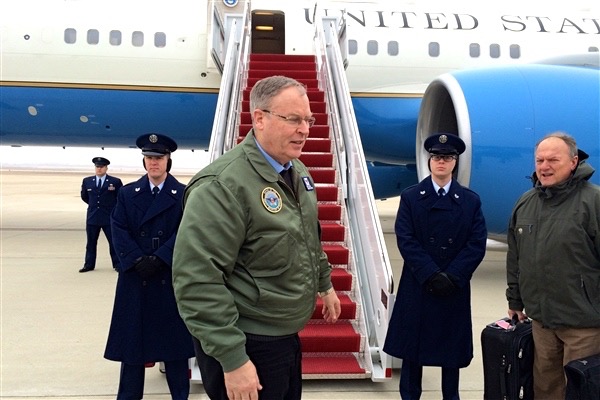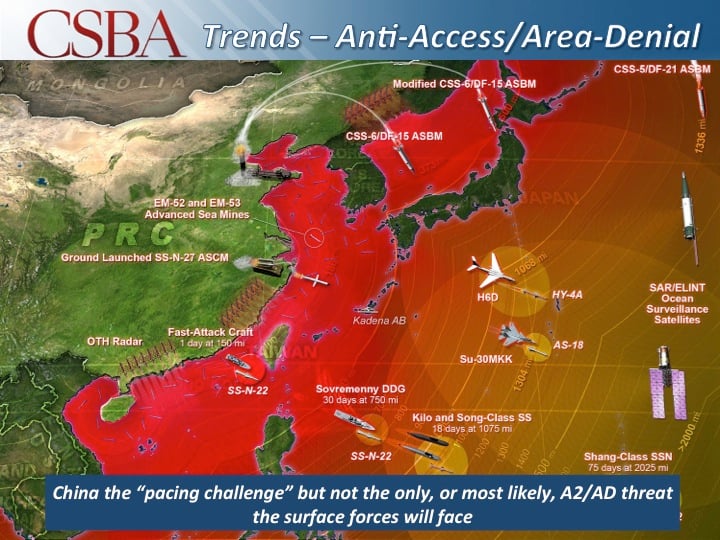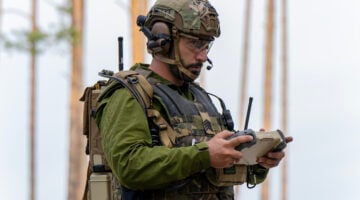
UPDATED from further Work remarks WASHINGTON: The former deputy secretary of defense who launched Project Maven and jumpstarted the Pentagon’s push for artificial intelligence says the Defense Department is not doing enough. Bob Work made the case that the Pentagon needs to adopt AI with the same bureaucracy-busting urgency the Navy seized on nuclear power in the 1950s, with the Joint Artificial Intelligence Center acting as “the whip” the way Adm. Hyman Rickover did during the Cold War.
“There has to be this top-down sense of urgency,” Work told the AFCEA AI+ML conference today. “One thousand flowers blooming will work over time, but it won’t [work] as fast as we need to go.”
Work, now vice-chair of the congressionally chartered National Security Commission on Artificial Intelligence, told the conference yesterday that China – and Russia “to a lesser extent” – could overtake the US in military AI and automation. To keep them at bay, he said, the U.S. needs to undertake three major reforms:
- Set aside 1 percent of the defense budget – about $7 billion a year – for artificial intelligence projects, with the armed forces competing for the pool of funding every year.
- Create a public-private partnership between the Pentagon, academia and the private sector to compete with China’s strategy of civil-military fusion. The goal is to make it easier for the military and civilians to share AI technology and technique. The biggest single step here: create a national center for testing, evaluation, verification, and validation (TEVV) of new AI algorithms – which are notoriously opaque and unpredictable, even to their creators – that uses high-quality data protected by Pentagon cybersecurity against theft.
- Strengthen the Joint Artificial Intelligence Center, created just two years ago. First, have the JAIC report directly to the secretary or deputy secretary of Defense (something Congress is now considering. Second, expand its mandate to include automation writ large (accordingly renaming it the “JAAIC”). Third, give it the kind of authority over all the service’s AI standards that the Navy’s Nuclear Reactors program — founded by the legendary Adm. Hyman Rickover — has over the nuclear fleet.
Work added Wednesday that the US should also consider replicating the Chinese model of a single unified Strategic Support Force overseeing satellites, cyberspace, electronic warfare, and information warfare — functions that the US splits between Space Command, Cyber Command, and other agencies. Given how interdependent these functions are in the modern world, he said, “I think the unified Strategic Support Force is a better way to go, but this is something that would need to be analyzed, wargamed, experimented with.”

Rickover, Reprise?
“We’re all saying the right things: AI is absolutely important. It’s going to give us an advantage on the battlefield for years to come,” Work said. “But the key thing is, where is our sense of urgency? We may be losing the race, due to our own lack of urgency.”
For the US to keep up requires not only funding, Work said, but also a new sense of urgency and new forms of organization, he said: “I would recommend that we adopt a Naval Reactors-type model.”
At the dawn of the nuclear era, Congress promoted Hyman Rickover over the heads of more-tradition-minded admirals and empowered him as chief of Naval Reactors, which set strict technical standards for the training of nuclear personnel and construction of nuclear vessels. The remit of “NR” extended not only across the Navy but into the Energy Department, giving it an extraordinary independence from both military and civilian oversight.
How would this model apply to AI? Work proposes giving the Joint Artificial Intelligence Center – to be renamed the Joint Autonomy & AI Center – the role of “systems architect” for “human-machine collaborative battle networks… the most important AI-enabled applications.” To unpack this jargon, the JAIC/JAAIC would effectively set the technical standards for most military AI projects and control how they fit together into an all-encompassing Joint All Domain Command & Control (JADC2) system sharing data across land, sea, air, space, and cyberspace.
Cross Functional Teams run by the JAIC for different aspects of AI would have to “certify” that any specific program had significant “joint impact” for it to be eligible for a share of the added $7 billion in AI funding, Work said. In some cases, he said, the JAIC could compel the services to invest in AI upgrades that they might not want to find room for in their budgets, but which would work best if everyone adopted them, much as then-Defense Secretary Bill Perry forced the services to install the early versions of GPS on vehicle, ships, and aircraft.
“I’m recommending a much more muscular JAIC,” Work said Wednesday. “You have to tell the JAIC, ‘you’re the whip. You’re going to be the one recommending to the senior leaders, what are the applications and the algorithms that we need to pursue now to gain near-term military advantage?’”
These proposals would upset rice bowls in the Defense Department and industry alike, making reform an uphill battle both politically and bureaucratically. “What I’m proposing…all of the services would fight against,” Work admitted.
But Work remains highly respected in the defense policy world – and if Joe Biden becomes president in November, Work could well be back in the Pentagon again.

Work has a lot of credibility in this area. A retired Marine Corps artillery officer, he spent years in government and thinktank positions, rising to Deputy Defense Secretary during the Obama Administration. Work warned that China and Russia had advanced their military technology dramatically while the US waged guerrilla warfare in Afghanistan and Iraq, and he convinced Sec. Chuck Hagel to launch the Third Offset Strategy to regain America’s high-tech edge. While the name died out after the Trump administration took power, the emphasis on great power competition in technology – especially AI – has only grown at the Trump Pentagon, despite the president’s own ambivalence about containing China and his outright refusal to confront Russia’s Vladimir Putin.
Just yesterday, the Defense Department released an alarming new report saying China has pulled ahead of the US in shipbuilding, missile defense, and offensive missiles. The People’s Republic in large part owes its rapid advance to the government-mandated collaboration between military and industry, the report says, with China harvesting foreign technology from both international collaboration and outright theft. “[There is] not a clear line between the PRC’s civilian and military economies, raising due diligence costs for U.S. and global entities that do not desire to contribute to the PRC’s military modernization,” the report states.

Work likewise prioritizes China as the most dangerous competitor, although he notes that Russia is remarkably advanced in military robotics. But robotic vehicles and drones are just one aspect of AI and automation, Work says. Equally important – and a major strength for China – is the intangible autonomy of software systems and communications networks that comb through vast amounts of sensor data to spot targets, route supplies, schedule maintenance, and offer options to commanders.
Since algorithms are invisible, it’s much harder to calculate the correlation of forces today than in the Cold War, when spyplanes and satellites could count tanks, planes, and ships. For example, Work said, the right automation package could convert obsolete fighter jets from scrapyard relics to lethal but expendable drones able to out-maneuver human pilots — a possibility hinted at in DARPA’s recent AlphaDogfight simulation where AI beat human pilots 5-0.
An AI-driven world will be “rife with surprise,” Work warned. “If you had a great new AI into a junky old MiG-21 or MiG-19, and you come up against it, it’s going to surprise the heck out of a [US] pilot because it’s going to be a lot more capable than the platform itself might indicate.”

